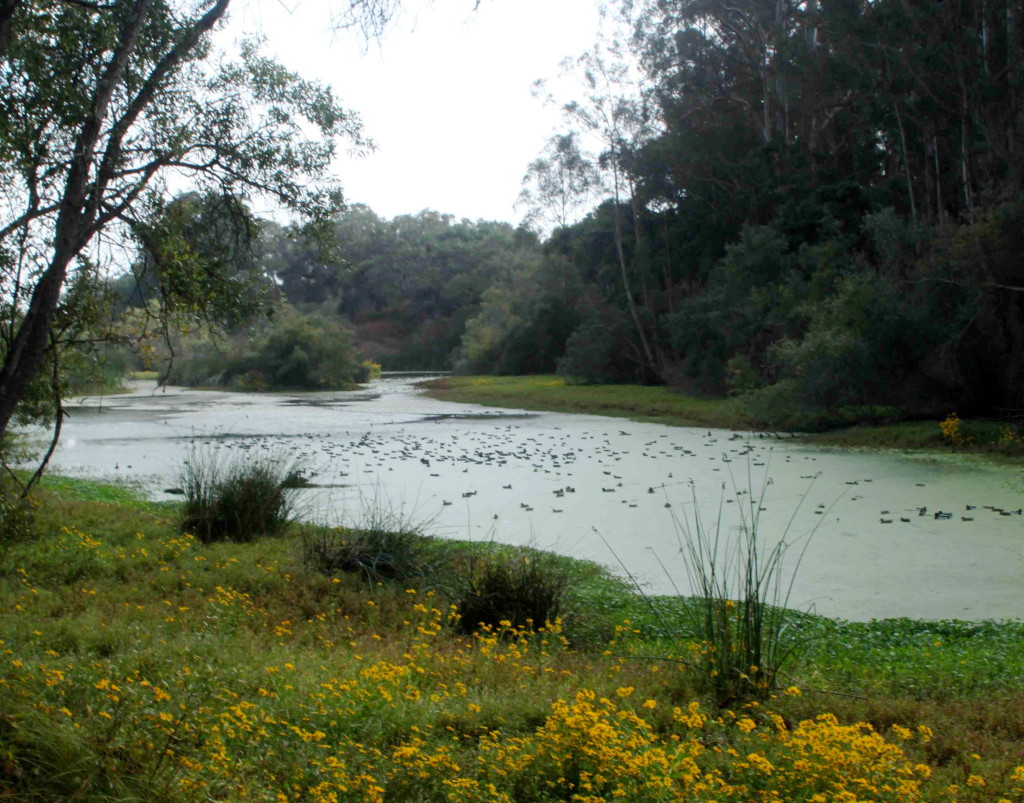A microbe that thrives in the warm shallow waters of Watsonville’s Pinto Lake spiked toxin levels to 750 times the state’s safe recreational exposure limit in 2011, and created unsafe levels again this fall.
Microcystis aeruginosa, a globally distributed cyanobacteria, causes problems for people and a wide variety of animals and has been blamed for the death of at least 21 southern sea otters in the Monterey Bay.
In warm weather it rises to dangerous levels in Pinto Lake, and has been found recently in increasing concentrations in the San Francisco Bay where toxins are accumulating in the food chain and poisoning marine wildlife. As climate change continues to create the warm water environments that fuel its growth, understanding Microcystis ecology is becoming increasingly important.
“They’re a gnarly beast and we’re still trying to figure them out,” said Robert Ketley, Watsonville’s senior utilities engineer.
Since its cells are buoyant, Microcystis sits on the top of the water in thick green mats, soaking in the sunlight and in turn preventing light from reaching the water below. The cyanobacteria prevent the lake water from mixing, thus preserving their preferred warm habitat at the surface.
Once Microcystis takes root, the lake’s profile of plankton and algae changes. The organisms that are eaten by everything, such as diatoms, tends to disappear while unpalatable Microcystis and other potentially toxic cyanobacteria blossom. Microcystis is so successful at taking in the nutrient ammonium that it outcompetes many beneficial organisms and dominates the environment.

Perhaps the strangest thing about the cyanobacteria is that no one knows why it even produces its toxins, called microcystins. The toxins don’t kill competing microorganisms, and since few animals eat them, they aren’t a defense mechanism. Some researchers believe that the toxins are a holdover from a previous point in the cyanobacteria’s evolutionary history, or that they are related to photosynthesis.
“There are over 4,000 or so – probably 5,000 by now – publications on Microcystis and no one can answer that basic question,” says Peggy Lehman, an expert in plankton ecology at the California Department of Water Resources.
It would be easier if Microcystis had a natural enemy, but there are few species that will willingly eat it— clams even spit it out, Lehman said.
“You’re not going to really get rid of it,” she said. “The question is, can you keep it to a level which is not harmful?”
“Not harmful” is perhaps the best goal that Watsonville can hope to attain. Algal blooms have persisted in the lake for decades, but only recently have toxin concentrations risen to alarming levels.
On a clear fall day, a heron stalks its prey through the green froth blanketing Pinto Lake’s shallows. In the surrounding oak forest, hikers amble along the trails, cameras in tow, hoping to catch a glimpse of a bald eagle. Across the lake, mothers and toddlers toss bread crumbs to a huddle of mallards and white ducks, while families sit at their picnic tables watching the action unfold.
“This is where people come for their birthday parties, their baptisms,” says Patricia McQuade, who formed the community action group Friends of Pinto Lake to educate residents about the problem and its potential solutions. “People have brought their kids here for generations.”

Some four miles from downtown Watsonville, Pinto Lake is bordered by a county park to the north, houses to the west and the remaining lakefront property is farmland. Preliminary studies of the lake and its watershed have identified the main problems fueling the the cyanobacterial blooms: excess nutrients from fertilizer runoff, leaking septic systems and the lake’s own high phosphorous sediments.
Agricultural runoff has caused Microcystis blooms in many freshwater habitats, such as a record-setting algal bloom that occurred in Lake Erie in 2011. To keep the Microcystis in check, the city must reduce not only the existing phosphorous level in the lake, but prevent any additional phosphorus from entering via loose soil, poor farming practices and leaking septic tanks.
One way to lower the level of phosphorus in the lake is to add large quantities of a mineral called alum. Alum binds to the phosphorous and sticks to the bacterial cells so they clump up and settle at the bottom. It also helps seal the phosphorous-laced sediments. Alum treatments are generally safe, but engineers must monitor water quality so that pH changes do not kill fish and smaller animals.
Ketley, the city’s senior utilities engineer, is also considering floating mats of vegetation that would draw the phosphorus into the plants. He is working with local farmers to reduce runoff, and intends to plant cover crops in the watershed to stop erosion. Additionally, the city is considering installing sewer lines to the houses that line the lake. One of the stranger remediation strategies is a program that Ketley instituted, called “Carpageddon.” Watsonville will pay fisherman to catch the invasive carp that inhabit the lake. Since the fish are bottom feeders, they stir up the sediment and release more phosphorous into the water.
Despite the challenges, Pinto Lake and its surrounding watershed are small enough that the residents have a chance of controlling the phosphorous. “It’s not going to be very hard to rally every single person in Watsonville,” McQuade said. “Every single person in Watsonville has been to this lake sometime and all I have to do is reach them all.”
Because of its small size, Ketley views Pinto as a “laboratory-sized lake,” where they can affordably test different treatments. Successful remedies can then be applied to larger lakes where Microcystis dominates, such as Clear Lake, the Copco and Iron Gate reservoirs in Northern California as well as the San Francisco Bay.
Patricia Waldron is a science writing student at the University of California, Santa Cruz.


-300x224.jpg)